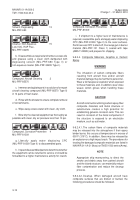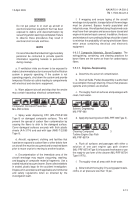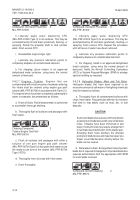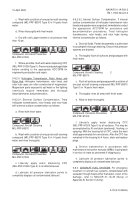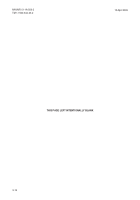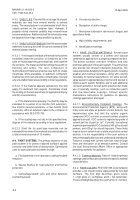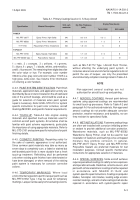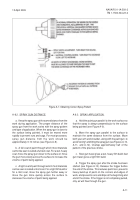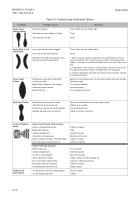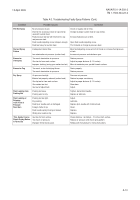TM-1-1500-344-23-2 - Page 175 of 240
A-5
NAVAIR 01-1A-509-2
TM 1-1500-344-23-2
15 April 2009
Since there is less overspray, it is easier to see the
surface being coated. Film build is faster than with
conventional spray equipment due to higher transfer
efficiency. Benefits include less material usage and less
paint booth maintenance due to less overspray. The
proper working distance of an HVLP gun is usually
closer than with a conventional paint spray gun. Due to
environmental regulations, an HVLP system must not
be operated at air cap pressures exceeding 10 psi.
Refer to manufacturer’s literature supplied with the
paint gun for proper operation and adjustment.
Figure A-2 illustrates the components of a typical HVLP
paint spray gun. Refer to Volume IV for ordering
information of the HVLP paint spray guns.
A-5.1.1. Transfer Efficiency. Application methods shall
be selected to minimize the amount of paint waste and
solvent emissions. Transfer efficiency is used to gage
the effectiveness of paint equipment and is represented
as a percentage of the amount of paint deposited on the
surface compared with the total amount of paint used.
Spray painting produces overspray and has much less
transfer efficiency than brush or roller application, but
produces a more uniform, higher quality paint film. The
EPA has established specific requirements for paint
spray equipment used on aircraft surfaces. High-volume
low-pressure (HVLP) spray equipment or electrostatic
spray equipment is recommended since they have
higher transfer efficiencies than conventional
high-pressure spray equipment. In addition, conventional
high-pressure spray equipment is no longer allowed in
most localities for use on aircraft surfaces due to
environmental restrictions. Consult the local
Environmental Affairs Office for guidance on selection
of proper paint spray equipment.
A-5.1.2. HVLP Equipment Options. HVLP spray guns
are suitable for painting both large areas and small
components. These guns can be fitted with a small cup,
usually a pint or quart capacity, or a pressure pot. A
pressure pot holds two or more quarts of paint and is
pressurized to force paint through a hose to the paint
spray gun. The amount of pressure supplied to the pot
is determined by the paint viscosity and length of paint
supply hose. Follow manufacturer’s recommendations
to set pot pressure.
A-5.2. TOUCH-UP SPRAY GUN. A touch-up spray
gun is used to apply paint to small areas using a small
spray pattern. Since these guns are used for small
areas, they are often acceptable under environmental
regulations. Consult the local Environmental Affairs
Office for guidance on the use of touch-up spray guns.
A-5.3. 3M PAINT PREPARATION SYSTEM (PPS).
PPS is a closed paint system that connects to both
siphon and gravity feed HVLP spray guns, allowing
mixing and spraying of paint materials from the same
disposable liner bag (see Figure A-3). Adapters are
available to convert existing spray guns to use PPS.
Instead of traditional rigid cups made of polyethylene,
aluminum, or stainless steel, the PPS includes a
collapsible liner bag in a plastic cup fitted with a lid and
built-in filter. As paint is sprayed, the liner bag collapses,
allowing the spray gun to function at any angle (i.e.,
sideways, upside down). This multi-angle capability is
especially useful for painting inside compartments, under
wings, or the bottom of the fuselage. Collapsed liner
bags and lids with built-in filter are disposable, leaving
only the spray gun and adapter to be cleaned. Unused
paint can be sealed in the liner with a sealing cap and
stored appropriately. PPS provides an efficient means
of applying paint materials, thus reducing paint waste
and minimizing time and cleaning solvents required for
cleaning paint spray gun assemblies.
A-5.4. ELECTROSTATIC EQUIPMENT. Electrostatic
paint spray equipment deposits paint on surfaces by
means of static electric attraction. The surface to be
painted and the coating material have opposing charges
which causes the coating to be attracted to the surface.
Electrostatic painting is useful for painting large areas
and, if used properly, produces little overspray with high
transfer efficiency. Due to electrical conductivity
requirements, this equipment is highly dependent upon
the type of coating (i.e., waterborne vs. solvent based)
and substrate conditions (i.e., metallic or nonmetallic).
Follow manufacturer’s recommendations and safety
precautions when operating this equipment.
A-5.5. BRUSH AND ROLLER. Brushes and rollers are
environmentally preferred alternatives for touch-up
painting since they produce little paint waste and do not
require solvent clean up. However, spray painting is
preferred where allowed by local regulations and
availability of proper personal protective equipment
(PPE), since the quality and uniformity of the paint film
is better than that achieved by brush or roller application.
Brushes and rollers must be constructed of durable
materials that will not be affected by solvents in the
coatings. Do not use foam brushes or foam rollers since
they are not solvent resistant. Refer to Volume IV for
appropriate brushes and rollers. Note that in addition to
the standard 1" wide brush, there are "acid brushes"
and "artist brushes" available for small or hard to reach
areas. Use rollers with the shortest nap possible in order
to achieve the best surface finish. Brushes and rollers
Back to Top


